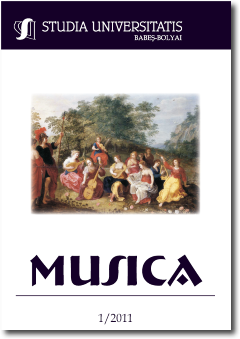SELF-SIMILARITY IN PITCH ORGANIZATION
Keywords:
self-similarity, tone-row, series, modAbstract
In this study we intend to discuss the self-similarity concept, which can be thought of as an organizing principle of the pitch of the sound. We will put emphasis on the self-similarity aspect of pitch organization in different series created by Anton Webern, and in several modes conceived by Olivier Massiaen, and Wilhelm Georg Berger. Also, we will investigate the author’s self-similar, non-octave-based, and full-chromatic mode of twenty-three notes, which led to the author’s compositions, such as Chaconne for guitar solo (1999), Fractus III for percussion and computer (2001), and Point. Line. Spot for string orchestra (2003).
References
Berger, Wilhelm Georg, Dimensiuni modale (Modal Dimensions), Editura Muzicală, Bucharest, 1979.
Marcus, Solomon, Artă şi Ştiinţă (Arts and Science), Editura Eminescu, Bucharest, 1986.
Messiaen, Olivier, Technique de mon langage musical (The Thechnique of My Musical Language), Éditions Leduc, Paris, 1942.
Niculescu, Ştefan, Reflecţii despre muzică (Reflections on Music), Editura Muzicală, Bucharest, 1980.
Vieru, Anatol, Cartea modurilor (The Book of Modes), vol. I, Editura Muzicală, Bucharest, 1980.
Webern, Anton, Calea spre muzica nouă (The Path to the New Music), Editura Muzicală, Bucharest, 1988.
Xenakis, Iannis, Muzica. Arhitectura (Music Arhitecture), Editura Muzicală, Bucharest, 1997.
Downloads
Published
How to Cite
Issue
Section
License
Copyright (c) 2011 Studia Universitatis Babeș-Bolyai Musica

This work is licensed under a Creative Commons Attribution-NonCommercial-NoDerivatives 4.0 International License.



